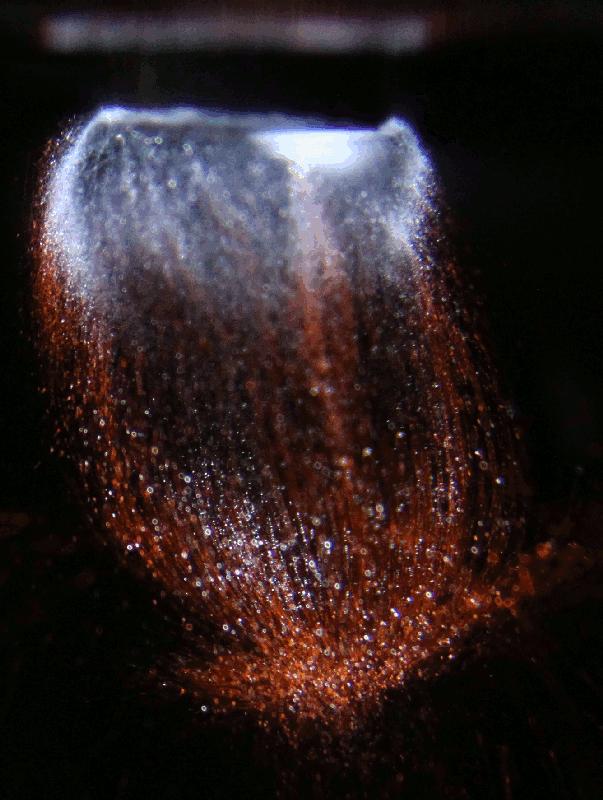Light-emitting bubbles captured in the wild

Coloured sonoluminescence of xenon in concentrated sulfuric acid with dissolved sodium salt University of Göttingen
High-power ultrasound is used for cleaning surfaces or wastewater as well as for destroying kidney stones. These applications use a curious effect caused when ultrasound enters liquids: bubbles are generated that periodically grow and collapse.
Imploding bubbles compress the gas they contain so strongly that light is emitted from the resulting “hot spot” – a phenomenon called sonoluminescence. At the University of Göttingen, physicists Dr. Carlos Cairós and Dr. Robert Mettin have imaged, for the first time, sonoluminescence flashes together with the bubbles in an ultrasonically driven bubble cloud.
By high-speed video recording with up to 0.5 million images taken per second, light emitting bubbles can be identified and their shapes and oscillations analyzed. The scientists published their work in the journal Physical Review Letters.
While collapse and light emission of isolated bubbles have been well studied before in so-called bubble traps, the Göttingen experiments provide a major step towards understanding sonoluminescence in a more realistic environment of applications of high-power ultrasound: chaotic “wild” ensembles of many moving and interacting bubbles, where collisions and splitting of bubbles frequently occur.
“A particular observation is that the light-emitting bubbles do not need to be perfectly spherical – which would be the optimum shape for the extreme energy focusing in the collapse”, says Dr. Cairós. “Even bubbles pierced by a liquid jet are observed to emit light, a fact that might explain certain chemical reactions in the bubbles.”
The observation technique developed in Göttingen can detect which bubbles in a cloud produce light and can also quantify the intensity. “This photometry of sonoluminiscence may help to optimise applications of high-power ultrasound”, says Dr. Mettin.
The study was conducted in the framework of the “Christian Doppler Laboratory for Cavitation and Micro-Erosion“, a research project funded jointly by the Austrian government and the Austrian-based company Lam Research AG.
The project investigated innovative methods of surface cleaning for the semiconductor industries during the past seven years, in parallel with studying the fundamentals of bubble formation in liquids.
Original publication: Carlos Cairós, Robert Mettin, Simultaneous High-Speed Recording of Sonoluminescence and Bubble Dynamics in Multibubble Fields, Physical Review Letters 118, 064301 (2017), DOI: 10.1103/PhysRevLett.118.064301, http://journals.aps.org/prl/abstract/10.1103/PhysRevLett.118.064301
Notes to editorial teams:
We have posted images to download on this subject at http://www.uni-goettingen.de/en/3240.html?cid=5758
Contact:
Dr. Robert Mettin
Georg-August-Universität Göttingen, Faculty of Physics – III. Institute
Christian Doppler Laboratory for Cavitation and Micro-Erosion
Friedrich-Hund-Platz 1, 37077 Göttingen
Phone: +49 (0)551 39-22285
Mail: robert.mettin@phys.uni-goettingen.de
Website: www.physik3.gwdg.de/~robert/
http://www.uni-goettingen.de/en/3240.html?cid=5758
http://journals.aps.org/prl/abstract/10.1103/PhysRevLett.118.064301
Media Contact
All latest news from the category: Physics and Astronomy
This area deals with the fundamental laws and building blocks of nature and how they interact, the properties and the behavior of matter, and research into space and time and their structures.
innovations-report provides in-depth reports and articles on subjects such as astrophysics, laser technologies, nuclear, quantum, particle and solid-state physics, nanotechnologies, planetary research and findings (Mars, Venus) and developments related to the Hubble Telescope.
Newest articles

Bringing bio-inspired robots to life
Nebraska researcher Eric Markvicka gets NSF CAREER Award to pursue manufacture of novel materials for soft robotics and stretchable electronics. Engineers are increasingly eager to develop robots that mimic the…

Bella moths use poison to attract mates
Scientists are closer to finding out how. Pyrrolizidine alkaloids are as bitter and toxic as they are hard to pronounce. They’re produced by several different types of plants and are…

AI tool creates ‘synthetic’ images of cells
…for enhanced microscopy analysis. Observing individual cells through microscopes can reveal a range of important cell biological phenomena that frequently play a role in human diseases, but the process of…





















